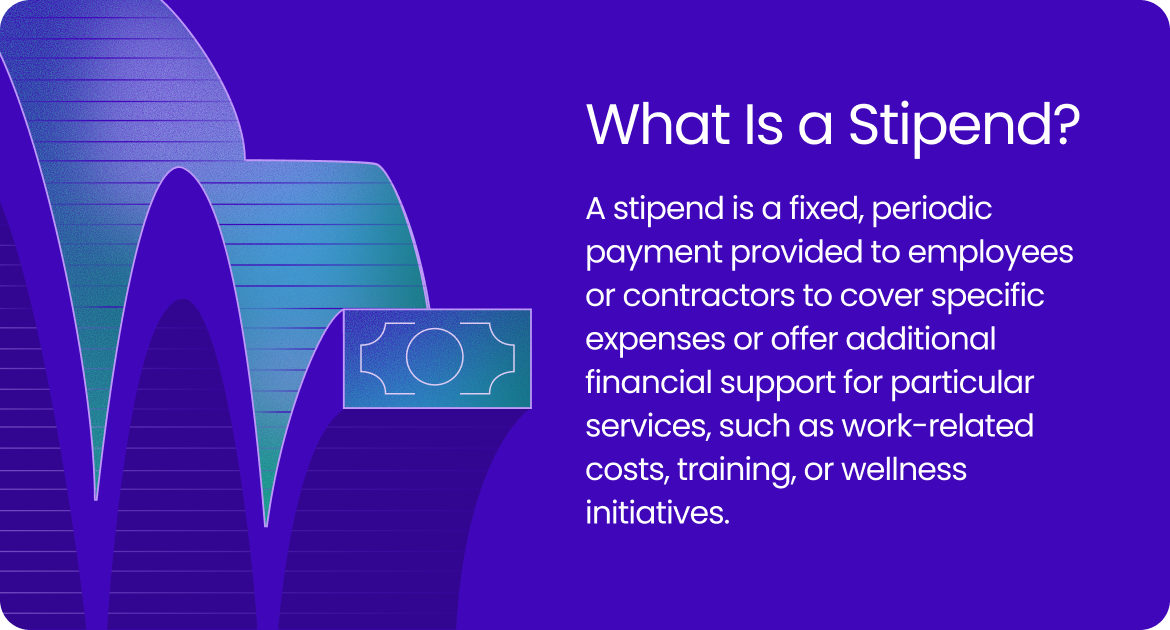In most cases, a stipend is considered a form of compensation or remuneration. In other words, it’s a fixed amount of money given to employees or contractors for specific purposes. They are often related to work expenses or additional benefits that can support professional development, wellness, or even health.
Unlike a regular salary, which is paid for the work someone does, a stipend is usually intended to cover things like office supplies, wellness benefits, or professional development. For remote workers and global teams, stipends have become a smart way to support employees without the complications of adjusting salaries.
For HR managers or global employers, stipends are a practical way to support your workforce and stay competitive. Offering stipends allows you to tailor benefits to your team’s needs, whether they’re working from home or across different countries.
Let’s dive in and see how stipends can fit into your global payroll strategy.

Types of Stipends
There’s no one-size-fits-all when it comes to stipends. They come in all shapes and sizes, depending on what your team needs.
Here are some common stipend types that you should know about:
1. Remote Worker Stipend
A remote worker stipend is designed to help employees cover the costs of working from home. This could include everything from setting up a home office to covering internet bills. For example, a company might offer a $500 stipend to help a remote employee buy a desk, chair, or other necessary equipment to stay productive. Tech companies like Google offer these types of stipends to their remote employees.
2. Work From Home Stipend
This is similar to a remote worker stipend but focuses more specifically on day-to-day work-from-home expenses. Think of it as a contribution toward things like internet access, phone bills, or even a gym membership to help your employees balance work and well-being.
3. Payroll Stipend
A payroll stipend is added directly to your employee's paycheck. These are typically used to help cover job-related expenses like travel, meals, or professional memberships. It’s a straightforward way to pay for things that support an employee’s role without having to adjust their base salary.
4. Internship Stipend
For interns, a stipend is a great way to compensate them without paying a full salary. These stipends typically cover living expenses or help support the intern’s time, making internships more accessible for students who might not be able to afford unpaid roles. Startups like GitLab and Stripe offer internship stipends to attract top talent, providing financial support while offering valuable work experience.
5. Training Stipend
A training stipend helps employees cover the cost of learning and development. Whether it’s for a course, certification, or workshop, this stipend shows your commitment to your team’s growth, while helping them build the skills needed to grow your business at the same time. Many companies now provide training stipends as part of their professional development packages.
6. Wellness Stipend
A wellness stipend helps support your employees’ overall health and well-being, beyond just their work tasks. As the world moves away from hustle culture and embraces a slower, more balanced way of living, employers are recognizing that happy, well-rested and happier employees are more productive. Whether it’s for gym memberships, mental health support, or even wellness retreats, these stipends help employees take care of themselves both physically and mentally.
Benefits of Stipends for Organizations
According to new studies from Wellhub, 88% of employees in the U.S. believe their well-being at work is just as important as their salary. Stipends can be a win-win for both employees and employers, especially when it comes to building a healthy workplace culture and reducing employee turnover.
Here’s how stipends can benefit both your business and your team:
1. Boost Employee Morale
When employees know you’re offering stipends for things like wellness or home-office setups, it makes them feel valued. You’re paying attention to the pain points that come with trying to balance the personal and professional aspects of our lives. Something as simple as a ‘free’ coffee once a week or dinner when your employees work over time for example, can go a long way.
It’s a small gesture with a big impact, showing that you care about more than just their outputs, and it’ll undoubtedly boost your team’s morale. This naturally leads us into the next benefit.
2. Better Employee Retention
Offering targeted benefits like stipends do more than you think when it comes to improving employee retention. When your team feels supported, they’re less likely to spend lunch breaks scrolling through job sites and more likely to stay loyal to your company.
3. Attract Top Talent
Stipends also help set your company apart from competitors, especially when hiring remote workers. Candidates looking for flexibility and benefits that match their work-life needs are more likely to be drawn to a company that offers stipends tailored to these needs.
By offering a mix of training stipends, wellness stipends, and work-from-home stipends, you’re also able to attract a diverse range of talent.
4. Support for Global or Remote Teams
For companies with remote teams or employees spread across different countries, stipends provide an easy way to support employees without the complexity of adjusting salaries. They offer flexibility to meet various needs, such as home-office setups, wellness, or commuting benefits.
Legal and Tax Considerations
When introducing stipends to your compensation or benefits packages, it’s important to be aware of the legal and tax considerations involved. Just like with any payroll adjustment, knowing the ins and outs of stipend taxation is key.
1. Stipend Taxation
In most cases, stipends are taxable, but the rules can vary based on the type of stipend. Some stipends are considered taxable income, while others might not be, depending on what they’re being used for.
- Taxable Stipends: If the stipend is treated as compensation for work, like a payment for specific job responsibilities or services rendered, it’s generally taxed as income.
- Non-Taxable Stipends: On the other hand, if the stipend is meant to cover work-related expenses, such as wellness programs or home-office equipment, it may be non-taxable in some cases.
Figuring out which stipends are taxable and which aren’t can be tricky, especially when it comes to staying compliant with international tax laws and payroll guidelines changing across regions. Our experts can help you stay on top of shifting labor laws globally – book a free consult here.
2. Stipend vs. Salary
A stipend is different from a salary. While salaries are regular payments made for work, stipends are typically offered for specific purposes, like covering certain expenses or supporting remote work. Stipends usually have fewer tax implications and are less formal than salaries, but they still need to be tracked carefully.
Stipends are also typically paid on top of regular salary or compensation packages, whereas salaries are inclusive of all compensation. Companies often find stipends easier to manage for specific expenses, especially for remote workers or interns.
Understanding Stipends at a Glance
Stipends are a practical tool for HR managers and global employers looking to support their team’s well-being, professional growth, and work-life balance. By offering stipends tailored to the needs of remote or global workers, you can boost employee morale, retention, and attract top talent.
If you haven’t already, take a moment to review your compensation strategy and consider adding stipends that speak to your team’s needs.
Leverage local experts to onboard, pay and manage your global team with ease.
Learn More
Stipends FAQs

.png)
A stipend is a fixed amount of money given to an employee or contractor to cover specific expenses or as additional compensation. Unlike salaries, stipends are often designed to cover things like home office equipment, wellness, or professional development.

.png)
Yes, stipends are generally taxable, though it depends on the type. If it’s a payment for work or services, it’s usually taxed as income. If it’s for specific expenses (like wellness or commuting), it may be non-taxable.

.png)
The main difference is that salaries are fixed, regular payments made for work, while stipends are usually one-time or periodic payments that cover specific expenses or additional benefits. Stipends don’t have the same tax or legal requirements as salaries.
.svg)
.svg)
.svg)
.svg)
.svg)





.svg)



.svg)



















.svg)